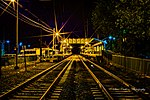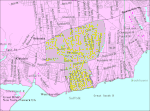Sayville National Wildlife Refuge

The Sayville National Wildlife Refuge is a 127-acre (51 ha) National Wildlife Refuge (NWR) located in West Sayville, New York about two miles (3.2 km) inland from the Great South Bay. Sayville NWR is managed by the U.S. Fish and Wildlife Service as a sub-unit of Wertheim National Wildlife Refuge and part of the Long Island National Wildlife Refuge Complex. It is the only land-locked refuge in the complex. Sayville consists primarily of oak-pitch pine forests interspersed with grasslands. This sub-unit supports a diversity of migratory songbirds and raptors. The refuge contains the largest population of sandplain gerardia (a federally endangered plant) in the state of New York. Management activities focus on protecting and enhancing habitat for this endangered plant and for migratory birds.
Excerpt from the Wikipedia article Sayville National Wildlife Refuge (License: CC BY-SA 3.0, Authors, Images).Sayville National Wildlife Refuge
Locust Avenue,
Geographical coordinates (GPS) Address Nearby Places Show on map
Geographical coordinates (GPS)
| Latitude | Longitude |
|---|---|
| N 40.7477 ° | E -73.1051 ° |
Address
Locust Avenue 379
11769
New York, United States
Open on Google Maps








